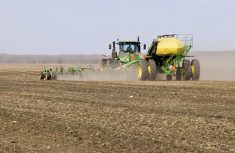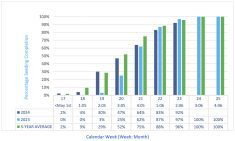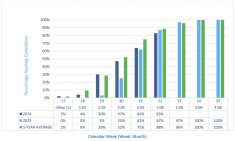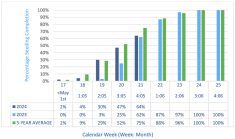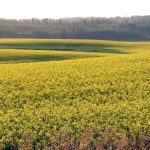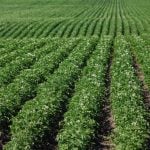Overview
Harvest has started in winter wheat and fall rye, with a good portion of those crops already combined. Reported yields are average for both crops, falling numbers are good in rye crops harvested prior to heavy rains last week, and no results yet on crop yet to be combined.
Crop condition looks good to very good in most parts of the province, field pea harvest has begun in the Northwest and Southwest regions, and widespread harvest is expected to begin for spring cereals in about two weeks, with some early spring wheat, barley, and oats coming off in the past few days in the Central Region.
Read Also

A place of national honour for former deputy ag minister, Dori Gingera-Beauchemin
Long public service, focus on community and industry leadership launch Dori Gingera-Beauchemin into 2025 Canadian Agricultural Hall of Fame honourees
Early spring wheat harvest indications in the Eastern and Central regions are showing CWRS (Canadian Western Red Spring Wheat) protein ranging between 12.5 to 14.3 per cent, with good falling numbers and slightly higher FDK (fusarium damaged kernels) than recent years, but low DON (deoxynivalenol) levels, and mostly grading No 1 CWRS.
High humidity and frequent rain showers are slowing cereal and pea crop drydown, despite warm sunny days. A cooler, wetter forecast for the remainder of August has farms reconsidering swathing in favour of a pre-harvest aid or straight cutting in cereals.
The Manitoba Hay Listing Service is active; producers with extra feed or looking for feed are encouraged to list their available supplies for sale.
Cereals
Winter cereal grains
Fall rye harvest is still ongoing, with a wide range of completion across the province. Yields are reported between 45 to 110 bu/acre, averaging between 75 to 90 bu/acre. Straw volumes are high and swathing is common.
Higher levels of ergot have been reported in fall rye.
Many farmers have commented that they are intending to seed more fall rye this autumn if conditions remain favourable, especially on ground that had been summerfallowed due to excessive moisture.
Many winter wheat fields are harvested, yield reports are between 30 to 75 bu/acre, averaging in the 60 bu/acre range. Harvest has progressed sporadically as high humidity has not allowed for much natural
drying.
Winter wheat quality has been variable, with higher fusarium reports in the Eastern region, but low DON
(deoxynivalenol) levels. Most wheat is grading No 2 CWRW with protein in the mid 10 to high 13 per cent range.
Spring cereal grains
Spring wheat is drying down, and kernel development has reached hard dough in most locations (Zadoks 87 to 91). The spring wheat crop is rated mostly good to excellent, and pre-harvest application is underway on the earliest crops. Pre-harvest application may be more common this year as crop maturity is less uniform in some locations due to delayed seeding/emergence.
Wheat crops have elevated levels of foliar disease due to favourable conditions, septoria and smut are more common this year.
Early harvest indications in the Eastern and Central regions are showing CWRS wheat protein ranging between 12.5 to 14.3 per cent, with good falling numbers and slightly higher FDK (fusarium damaged kernels) than recent years, but low DON levels, and mostly grading No 1 CWRS.
Many barley crops have reached hard dough stage, with malt crops most advanced, and greenfeed or very late-seeded fields further behind. Pre-harvest application has started in many fields intended for livestock feed, while malt fields are generally straight-cut. Barley delivered to grain buyers has been tough (>13.5 per cent seed moisture).
Oat crops are reaching hard dough in the most advanced fields, preharvest spray and swathing has started in a few locations, most are still waiting for crops to advance a little more.
Oat grain quality has been good, earliest fields have seen test weights between 38 to 40 lbs/bushel Avery.
Corn
Corn development ranges from R2 (blister stage) to R3 (milk stage).
Silks are dry and dropping off the ear, seed fill is ongoing.
Oilseeds
Canola
Canola crops are variable across Manitoba, with many in excellent condition, and tabling canopy, and others in poor condition with thin stands. Crop staging ranges from late bloom to very early harvest, with much of the crop between 10 to 50 per cent seed colour change.
Large areas of late-seeded canola along the Yellowhead Highway (PTH 16) and north toward Riding Mountain National Park are in late bloom, and require several weeks of good growing conditions to mature.
Much of the canola in the southern belt of the province is rapidly nearing swathing (40 per cent seed colour change), and some desiccation has started on the most advanced fields, while swathing is occurring for weedier or more uneven fields in the Red River Valley.
The annual canola disease survey is underway, where a geographic-weighted survey will assess a
representative sample of fields for blackleg, sclerotinia, verticillium, clubroot, and other diseases.
Insect pressure remains low in canola, except in the northern Interlake and Swan Valley, where lygus bug populations have exceeded economic thresholds.
Flax & sunflowers
Flax bolls are filling. Bolls have started to turn colour from green to tan, rapid advancement was reported this week. In general, flax crops are in excellent condition this year.
Sunflowers are in the R5.8 to R7 stages, with most disc florets now pollinated and ray petals dropping (R6) on the earliest hybrids, and now reaching R7 as the backside of the heads start to turn pale yellow.
Basal sclerotinia infection is prevalent in many sunflower fields, but incidence within a field remains low.
Pulses
Soybeans have reached the R5 to R6 stages, many fields in southern Manitoba could use a good rain soon to help fill the uppermost pods.
Scattered reports of soybean aphids in all regions, but concerns are declining as the crop advances.
Field peas in the Southwest region are mature and have been desiccated. Harvest will begin in earnest when humidity drops. Harvest has not yet begun in the Red River Valley and Eastern regions, crops are
dropping below 30% seed moisture content and preharvest application is widespread.
Harvest will be widespread once humidity drops and a few more sunny days allow for better drydown.
Dry bean stage ranges from R7 to R8. Some bacterial blight has been reported, but is not a major issue.
Late-season white mould has been discovered in bean fields, but it is generally too late to impact yields.
Special crops
Irrigation is still ongoing on potato fields, subsoils are drier below 4 inches depth where rainfall was not as frequent.
Colorado potato beetle pressure is high in the Winkler to Carman area and pressure may be expanding to other areas. Some resistant populations have been noted.
Potato crops are doing well overall, and are approximately 7 to 10 days behind normal given the seeding delays this spring.
Top-kill on fresh potatoes is nearly complete, and has begun on seed potatoes.
Forages & livestock
Forages
Dairy farms have completed second-cut hay, while beef cattle producers are continuing a second cut as weather allows.
Feed quality in the Eastern and Interlake regions is moderate to poor, given frequent rains on cut swaths and delays on reaching hay that is becoming too mature and coarse.
Barley silage yields are average to above average in the Southwest region, and cereal silage yields in the Northwest region are good, at 10 tonnes/acre.
Alfalfa has entered the critical fall harvest period, and cannot be cut until after a killing frost without increased risk of winterkill.
Livestock
Pasture growth has slowed, as expected for late summer, and cattle feed supplies are adequate.
Dugouts and sloughs are at 70 per cent capacity in the Southwest region, and nearly full in the Interlake and Eastern regions.
Livestock water supplies remain sufficient.
Regional comments
Southwest
A few scattered showers fell in parts of the region last week, but environmental conditions brought high humidity together with very sunny days. Some hail damage was reported south of Virden on spring wheat. Rainfall ranges from trace amounts from Reston through Deloraine and the extreme southwest, up to 50 mm near Oakburn, Minto and Kola, leading to some harvest delays there.
Harvest has started in fall rye and winter wheat, regional harvest completion sits at 2 per cent done. A very limited start to harvest in canola, spring wheat, and oats was reported this week. Pasture and hay crops have been outstanding this year, and first grass cut is nearly complete, while second-cut alfalfa is approximately half done.
Northwest
Generally a good week of growing conditions, with over night temperatures staying above 10 C, with the exception of Ste. Rose, Rorketon, and Reedy Creek areas. Daytime temperatures were high over the weekend. Warm temperatures have helped push crops towards maturity. Scattered showers mid week brought hail to areas north of Swan River – damage is still being assessed. Precipitation in Dauphin, Drifting River, and Ethelbert areas amounted to 15 mm, while Alonsa received 43 mm accumulated rainfall.
Fall rye harvest has begun in the Dauphin area, with very good yields reported. A limited start to field pea harvest is underway with no yields reported to date. Desiccation is ongoing in that crop. Insecticide applications for Lygus bug control have continued in the Swan Valley on canola crops, while grasshoppers remain a concern towards the Dauphin and Ste. Rose areas.
Central
Strong thunderstorm systems passed over the northern part of the region last week, leading to lodging in spring cereals in the Gladstone, Portage la Prairie, and St. François-Xavier areas. General crop quality has been good to very good, if crops avoided the excessive recent rains (above 25 mm). High humidity and frequent, short showers have hampered second-cut hay across the region, with approximately 20 per cent cut, and half baled, with the remainder still standing. As cereal, pea, and canola crops approach maturity, farmers are in a rush to desiccate or apply a preharvest aid to speed the time to combining. Most winter cereal crops are off, and the past few days saw a limited start to straight-cutting spring wheat.
The earliest spring wheat and oat crops have been harvested in the Red River Valley and, elevator indications show moderately better protein levels than expected given the wet year and good to excellent yields in both crops. Tough to damp grain has delayed a broader start to harvest, and more combines are expected to be rolling by this weekend, should the weather forecast become more favourable.
Eastern
Thunderstorms again stalled over the Eastern region late last week, resulting in rising rivers, flooding into riparian areas, and localized overland flooding and standing water in fields. The most extreme moisture accumulation was at Beausejour and Vivian, where over 140 mm rain has fallen since August 15th. Field access remains an issue across the region, but most restrictive in the northern districts where rainfall amounts were higher.
High humidity has prevented crop drydown, and hampered haying progress, resulting in frequently damp hay and lower quality hay. Aerial and ground-based pre-harvest spraying is ongoing for cereal, pea, and canola crops.
Interlake
Winter cereal harvest is approximately half done, with good yields, up to 100 bu/acre in fall rye, and 80 bu/acre in winter wheat. Drowned out areas are lowering field averages, but remaining parts of the crop are doing quite well considering the challenging moisture conditions this year. Pre-harvest spraying is underway on the earliest spring wheat and pea fields. Canola has finished blooming, except for the very latest seeded fields. There were reports of continued spraying for soybean aphids and lygus bugs exceeding thresholds in canola in the northern Interlake area.
Harvest of timothy seed has been delayed repeatedly by heavy rains and small showers, leading to concerns over seed shelling. High humidity has prevented baling of dry hay, and delaying a start to harvest.







